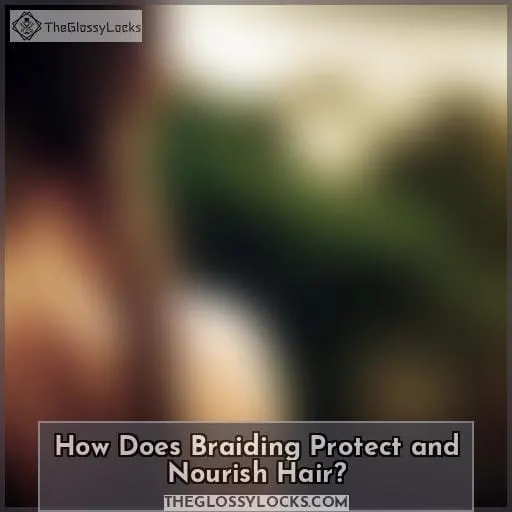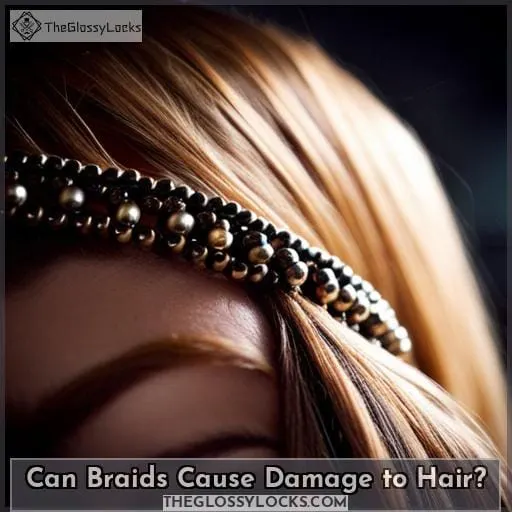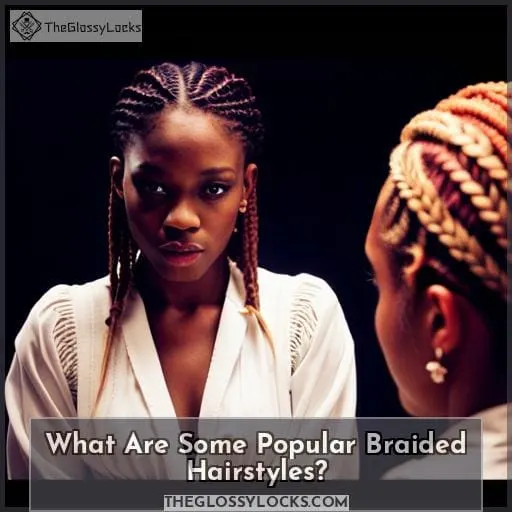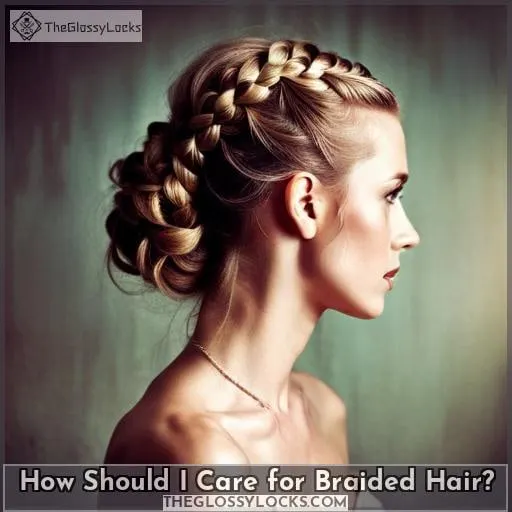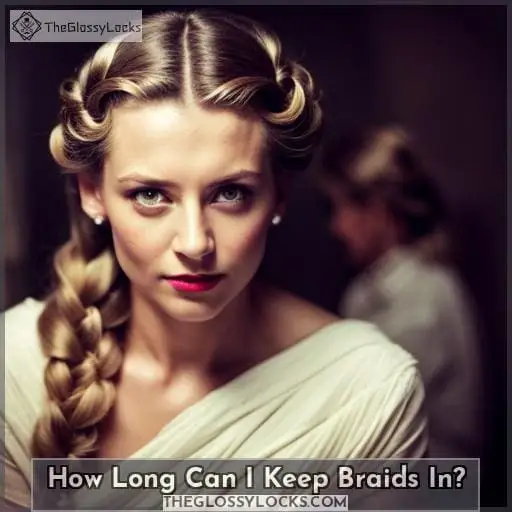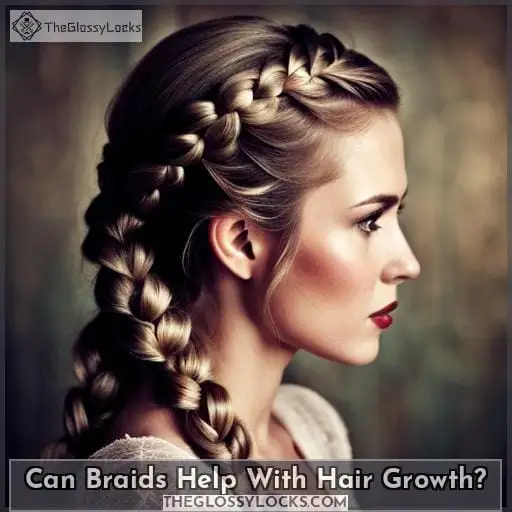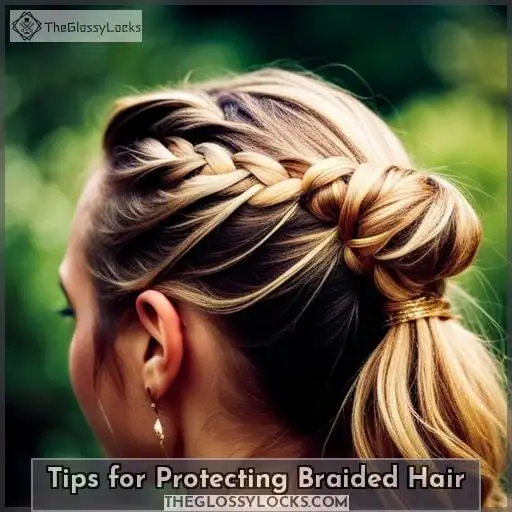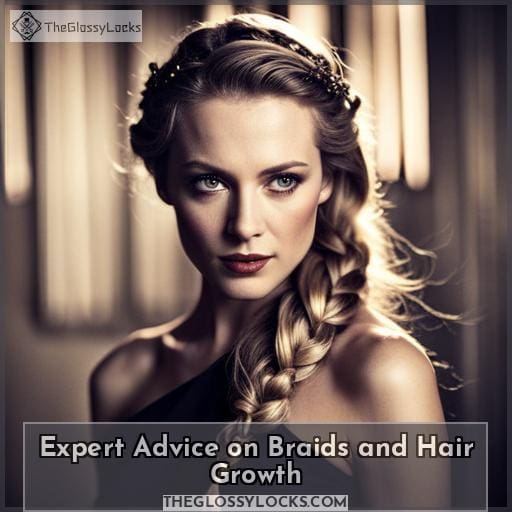This site is supported by our readers. We may earn a commission, at no cost to you, if you purchase through links.
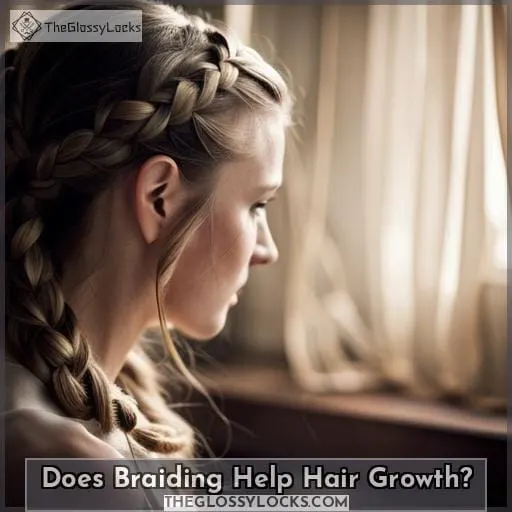 Curious about whether braiding can help your hair growth? There’s no simple answer, but understanding how the process works might be able to give you some insight.
Curious about whether braiding can help your hair growth? There’s no simple answer, but understanding how the process works might be able to give you some insight.
First off, it’s important to understand that all of us are born with a finite number of hair follicles – around 100,000 on our head alone – and these play an integral role in helping our hairs grow. Hair actually grows when oxygen and nutrient-rich blood is supplied by these follicles into the roots beneath them; meaning that while certain hairstyles like braids may have benefits for protecting existing strands from breakage or dryness, they won’t necessarily increase the rate at which new hairs sprout up.
However, there are other key factors like genetics and diet that will influence your individual results!
Table Of Contents
- Key Takeaways
- How Does Braiding Protect and Nourish Hair?
- Can Braids Cause Damage to Hair?
- What Are Some Popular Braided Hairstyles?
- How Should I Care for Braided Hair?
- How Long Can I Keep Braids In?
- Can Braids Help With Hair Growth?
- Tips for Protecting Braided Hair
- Expert Advice on Braids and Hair Growth
- Conclusion
Key Takeaways
- Braiding doesn’t directly increase hair growth rate.
- Braiding can provide protective benefits for hair, such as reducing friction and breakage.
- Traction alopecia and tight hairstyles can negatively impact hair growth.
- Proper scalp care and a healthy diet are important for promoting hair growth.
How Does Braiding Protect and Nourish Hair?
Braiding your hair is a great way to protect and nourish it. By reducing friction and breakage, maintaining moisture and strength, braided hairstyles can help keep your hair healthy while also creating beautiful looks.
Reducing Friction and Breakage
You can keep your hair healthy and strong by reducing friction and breakage, which can be achieved through the age-old art of braiding! Loose braids help reduce breakage by providing a strong structure.
Braided hair also minimizes contact with fabrics or skin, preventing frictional damage.
Sleeping with braided strands prevents nighttime breakage due to tossing and turning. Additionally, it keeps tresses tangle-free when brushing – avoiding potential snags that cause split ends or weak spots in the follicle shafts.
Braiding not only reduces friction but helps nourish strands too. When using oil prior to plaiting locks together, it enhances moisture levels while protecting against dryness.
Finally, traction alopecia is caused by tight hairstyles, so opt for looser looks if possible.
Maintaining Moisture and Strength
Slicking your locks with oil before you braid helps nourish and keep them moist, creating strong strands that can stand the test of time. Moisture retention is key for hair health—and braiding can provide a protective style while preserving moisture.
Oil application prior to braiding strengthens each strand, reducing breakage from friction between the fabric and scalp at night. Additionally, nighttime care such as sleeping with a headscarf or wrap further protects against frictional damage while promoting healthy scalp hydration levels throughout sleep.
Taking all these steps together will help promote healthy hair growth by keeping both your scalp and individual strands nourished through protective styling practices that encourage moisture retention over long periods of time.
Can Braids Cause Damage to Hair?
It’s no secret that braids can help protect and nourish hair, but it is important to know if they can also cause damage. Unfortunately, frequent or tight braiding styles have the potential to weaken hair over time and lead to breakage or even traction alopecia (hair loss).
In this article, we will discuss how these risks may be avoided in order for you to maintain healthy locks.
The Importance of Loose Braids
It’s important to opt for loose braiding techniques in order to protect and nurture your hair. Loose braids help prevent breakage by providing a strong structure, reducing friction between the hair and fabrics or skin.
Additionally, sleeping with braided hair prevents nighttime breakage from tossing and turning due to its tangle-free form. Braids also reduce tangles when brushing the hair as well as aiding in moisture retention, which helps enhance the strength of each strand of the braid.
Popular styling options like pigtails, milkmaids, or French braids offer great protection while being fashionable too! However, it’s essential to avoid traction alopecia by not keeping tight styles for prolonged periods.
Avoiding Traction Alopecia
To avoid traction alopecia, the last thing you want to do is pull your hair too tight, like tugging on a rope. It’s important to practice healthy hair practices when braiding and only use loose braids for protection.
Here are three tips:
- Use protective hairstyles such as pigtails or French braids, which require less tension than box or Dutch styles.
- Choose elastics that don’t have metal clasps—opt for fabric-covered bands instead, since they cause fewer breakages in the delicate hair follicles around them.
- Don’t keep any style of braid in longer than two months. Dirt and oil can accumulate quickly due to regular scalp contact, causing further damage if left unchecked.
With these precautions taken, you can enjoy all the benefits of safe hairdos without sacrificing the beauty or healthiness of your tresses!
What Are Some Popular Braided Hairstyles?
Achieving fashionable and protective hairstyles doesn’t have to be complicated. Popular braided looks, such as pigtails, can provide an easy and stylish look while also helping prevent hair breakage by providing a strong structure for your locks.
Pigtails
Try out pigtails for a classic look: two three-strand braids that will keep your hair tangle-free and reduce breakage. Add volume with hair care products and nutrient-rich foods to create the perfect combination of hairstyle, health, and protection.
Accessorize with headscarves or wraps to protect scalp health from overnight friction damage while sleeping in style.
Milkmaid Braids
For a special look, try milkmaid braids – intertwining two sections of hair and wrapping them around the crown for an elegant finish. Perfect for formal events or as variations to updos, this style is also seen on celebrities like Kim Kardashian West and Beyoncé! Here are some styling tips: use lightweight products such as mousses; section off small pieces of hair; keep it loose to reduce breakage; properly cleanse your scalp with lukewarm water before washing.
French Braids
Master your technique with French braiding, an intricate style that involves detangling hair and using small sections to create a beautiful look. With styling tips for different textures, learn the history of this iconic hairstyle and its cultural significance.
The main difference between Dutch and French braids is how the strands are crossed over each other – Dutch under while French over – resulting in unique looks.
To maintain their longevity and health, avoid heat damage or harsh styling products. Regular cleaning helps too! Nutrients found in eggs, fish, beans, and nuts can support strong hair growth while protecting it from breakage within these gorgeous styles.
How Should I Care for Braided Hair?
Caring for braided hair is essential to maintain its strength and moisture. Cleaning and moisturizing are important steps in the process, as dirt buildup can cause breakage, while sealing in hydration prevents dryness of the scalp.
Cleaning and Moisturizing
Maintaining your braided hair requires regular cleaning and moisturizing to keep it healthy. Scalp hydration, nighttime care, and detangling methods are all key elements of a successful hair maintenance routine.
Oil benefits help lock in moisture, while washing with the proper shampoo is important for removing dirt and debris from the scalp without stripping away natural oils.
Detangling using fingers or a wide-toothed comb helps prevent breakage when styling braids.
Hair growth is also encouraged by keeping tresses clean and free from buildup. This includes regularly cleansing locks and making sure they are adequately hydrated at night with protective wraps or scarves.
These wraps and scarves minimize friction between fabric surfaces like pillows and delicate strands.
Protecting Braids During Sleep
To protect your braids while you sleep, consider wearing a headscarf or wrap. Silk and satin fabrics provide the best moisture retention for African hair braiding styles. Hair wraps and bonnets also help retain moisture while protecting against damage from tossing and turning at night.
For an extra boost of hydration, cleanse your scalp with natural ingredients before bedtime for maximum benefits.
With proper care combined with protective measures during sleep time, you can maintain beautiful braided hairstyles all year round!
Avoiding Heat and Harsh Styling
When styling braids, be sure to avoid using heat and harsh products that can damage your hair. Opt for styling alternatives like air-drying, box braids, or protective styles. Invest in heat protection sprays and masks to prevent further damage when blow-drying or straightening hair with a flat iron.
Hair building fibers are also great for adding volume without the need for intense heat; use FiberHold Spray to lock them in place! Accessorize with scarves and hats during sunny days as UV rays can weaken strands too.
How Long Can I Keep Braids In?
When considering how long you can keep braids in, there are many factors that affect their longevity. This includes the type of braid, intensity, and how well you maintain your scalp and hair care routine.
With proper maintenance and understanding these factors beforehand, you can have healthier-looking hair for longer periods of time with braids.
Factors Affecting Longevity
Knowing the factors affecting braid longevity is key to keeping your hair healthy and strong. Haircare routines, diet impact, protective styles, and scalp health all affect how long braids can stay in.
For instance, a three-strand braid offers more protection than other styles but should be re-done every two months at most. Eating a balanced diet helps keep hair nourished, while regular conditioning keeps it hydrated.
Additionally, beauty treatments such as salon suite rental or consulting with a hair pro can help ensure your look lasts longer without damaging strands.
Recommended Timeframe for Braids
It’s generally recommended to keep braids in for no more than two months, as the longer they stay in, the higher your risk of traction alopecia and breakage. Protective styling is a great way to reduce damage from everyday activities such as brushing and tossing at night.
Popular braid hairstyles like pigtails, milkmaid braids, or French braiding can provide an easy yet stylish option for protective styling that will last up to two months with proper care. To ensure healthy hair while wearing a braid style, it’s important to use products designed specifically for this purpose, such as Hair Fattener Advanced Thickening Serum, which adds volume and shine without weighing down the hair strand, or Hair Building Fibers, which cover sparse areas adding instant volume while FiberHold Spray locks them into place all day long.
A well-rounded diet rich in essential nutrients like eggs, fish, beans, and nuts are also key components of maintaining healthy tresses underneath any hairstyle, including those achieved with braided styles.
Braids may not directly impact growth rate, but following these tips will help maintain strong strands until it’s time for removal.
Can Braids Help With Hair Growth?
When it comes to understanding hair growth factors, braiding can be a helpful tool. Braids protect and nurture the strength of your hair while reducing friction between your strands and pillows in order to prevent nighttime breakage.
Understanding Hair Growth Factors
Understand the factors affecting hair growth to maintain healthy, strong locks:
- Genetics influence – genetics can determine the rate of your hair’s growth.
- Diet – certain nutrients are vital for promoting good scalp health and strong tresses.
- Scalp health – a balanced diet and proper care of your scalp go hand-in-hand with growing thick, luscious locks.
- Lifestyle habits – heat styling or harsh products can damage hair over time and lead to breakage, which impedes on its overall growth potential.
Knowledge is power when it comes to caring for our mane. Understanding how these components work together will aid in preserving beautiful strands that we love so much! Taking preventive measures like using protective hairstyles, such as braids, helps protect against breakage while still allowing us to accessorize with versatile looks that make us feel confident in our own skin!
Maintaining Hair Health With Braids
By maintaining your hair health with braids, you can protect and nurture it while avoiding breakage that can slow down the growth process. However, be sure to choose loose styles to prevent traction alopecia, which could potentially lead to irreversible damage.
Braiding techniques such as pigtails, milkmaid braids, and French braids reduce friction between hair strands and fabrics or skin for better protection against breakage during sleep. Additionally, incorporating oil into the braid helps retain moisture in your locks.
Dietary support also plays an important role in strengthening weak strands prone to breaking.
Lastly, don’t keep them on too long – two months’ maximum – as dirt buildup from prolonged wear could hinder optimal performance of any hairstyle chosen!
Tips for Protecting Braided Hair
Protecting your braided hair is essential to ensure its health and vitality. With the right techniques, you can keep your hair looking beautiful while avoiding damage or breakage that could slow down growth.
Choosing the Right Braiding Techniques
Selecting the right braiding techniques can make all the difference in preserving healthy hair. To keep your scalp and strands safe, look for braiding methods that don’t unnecessarily tug on or pull at your roots.
Moisturize your hair before you braid to maintain a balanced moisture level throughout. Avoid tight hairstyles and styles that put too much tension on certain areas of the scalp to reduce traction risk.
Try experimenting with different types of braids like milkmaids, pigtails, or French ones to find out which works best for you! With these hairstyle options, there’s something for everyone looking to protect their locks with beautiful plaits!
Proper Hair Care Routine
To maintain your braids, it’s essential to establish a proper hair care routine that includes regularly cleaning and moisturizing your scalp. This helps keep the hair healthy and reduce breakage while preserving its natural texture.
Scalp massage can help stimulate blood flow to the follicles, promoting better growth for thicker strands over time. Furthermore, dietary intake impacts the overall health of our tresses. Foods rich in protein, like eggs, fish, beans, or nuts, should be part of an effective hair-growth regimen.
When wearing protective styles such as braided hairstyles at night, use headscarves or wraps to minimize friction between fabrics and skin contact.
Additionally, an adequate moisture balance is key when styling with braid extensions. Oiling them beforehand will ensure maximum hydration levels are met throughout their lifespan, reducing dryness significantly over time.
To achieve these goals consistently, practice makes perfect!
Expert Advice on Braids and Hair Growth
Gain insights from Colleen Welsch, a freelance beauty writer and blogger specializing in hair care, to understand the important role of braiding in protecting and nurturing your hair.
It’s essential to choose appropriate techniques: loose braids for strong structure; avoiding heat styling products; detangling before braiding.
Scalp health is also vital for long-term maintenance – wash, moisturize regularly with oil treatments.
Hair growth is largely determined by genetics but diet can play a part too – eggs, fish, beans & nuts are good sources of nutrients that promote healthy tresses.
Tight styles must be avoided as they can cause traction alopecia (hair loss).
Follow these tips and get creative with popular braid styles like pigtails or French plaits to unlock beautiful looks while keeping your locks safe!
Conclusion
Braiding can be a great way to protect and nurture hair, but it doesn’t directly impact hair growth. Genetics, diet, scalp care, and hair health are the primary factors influencing hair growth. To maintain healthy hair and maximize hair growth, it’s important to choose the right braiding techniques, avoid tight styles, and adhere to a proper hair care routine.
From pigtails to French braids, there are plenty of braided hairstyles to choose from that can keep your hair looking its best. With the right products and advice from experts, you can create beautiful, healthy, and voluminous hair with braids.

